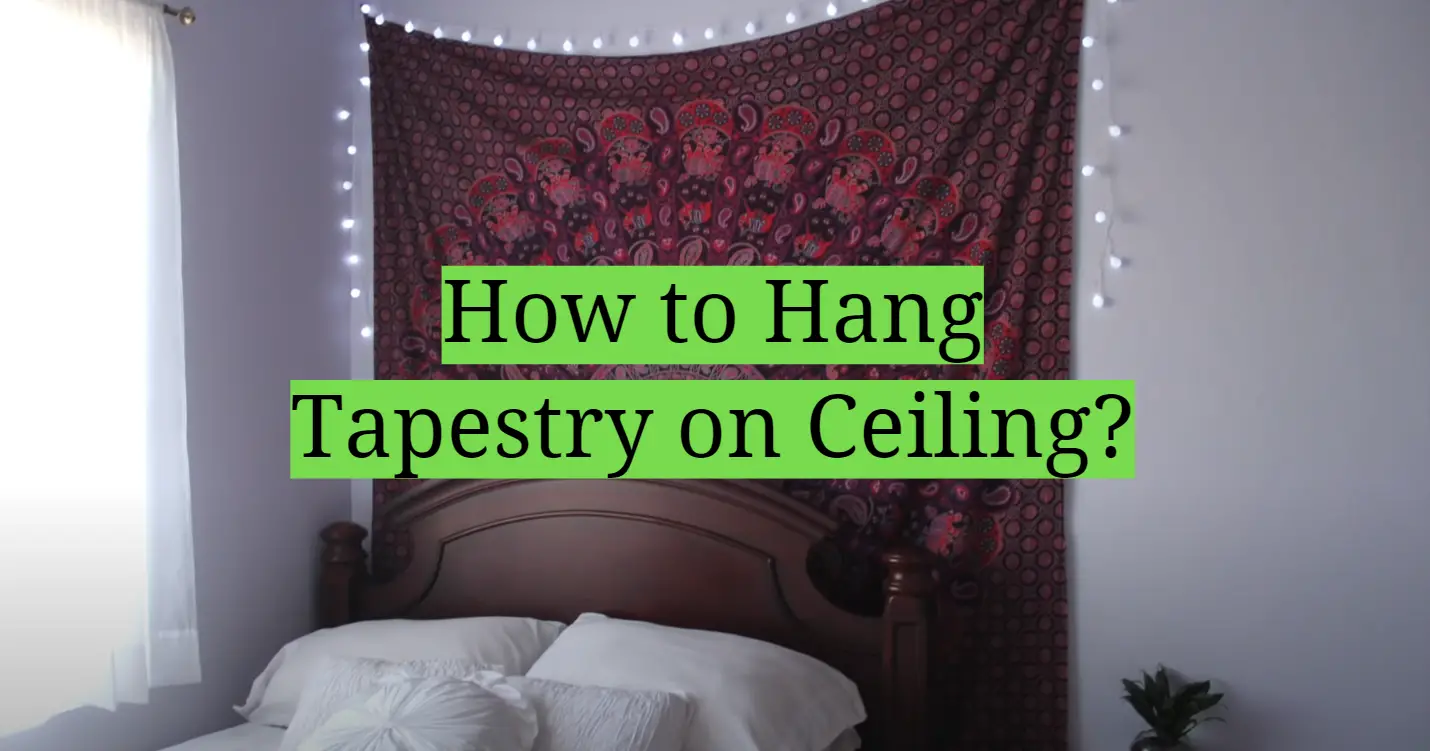The tapestry can add a nice touch to your home. It also acts as insulation and blocks noise from entering or leaving the room. But what if you don’t have walls large enough for hanging tapestries? You can also hang the tapestry on the ceiling.
Are you looking for a solution to the problem of how to hang a tapestry on the ceiling? If so, then this article is perfect for you. There are many different types of ceilings that can be found in homes and businesses around the world. The type of ceiling system you have will determine whether or not hanging your tapestry is possible. This article will provide instructions on how to hang tapestries on them!
How to Hang Tapestry on Ceiling – Step-by-Step Guide
Choose tapestry
Tapestry is usually made of cotton, wool, or silk. They are ornamental wall hangings rich in colors and patterns woven with yarns. You can choose your favorite color, scale, and pattern.
Preparation
If you want to hang a tapestry on the ceiling, find the studs in the wall and place anchors.
Measurement
Using a level tool, measure from both ends of your desired hanging point. Then mark where they intersect using masking tape or a pencil. This is where your center will be located when you proceed with actually marking for holes that need to be drilled into it. Make sure not to make any errors here because this might lead to an incorrect installation causing damage!
Mark out 4 points around this intersection point making them evenly spread apart from each other at 120 degrees. These marks are going to serve as locations where you are going to drill holes.
Use a piece of masking tape and mark the center point allowing you to align your tapestry with it. This is important because once drilling commences, there’s no turning back! You will then need to ensure that the tapestry actually hangs on correctly before putting up drywall anchors or screwing in hooks.
Place the anchors
Once measurements have been made using either masking tape or pencil marks, place the first anchor into the wall by applying pressure for about 5 seconds thus pushing it deep enough so that its flange is embedded within the wall surface area (applies only if you opted out of pre-drilling). If this doesn’t work try hammering down slightly harder.
Repeat this process for the remaining 3 holes and then finally place your tapestry on top of it, making sure that all four pieces are still aligned with each other! Afterward, you can proceed to either screw-in hooks or drywall anchors depending on what type of surface is being drilled into (wood vs plaster).
Just remember not to forget about using a level tool when drilling so as to ensure accurate measurements. That way there will be no need for any additional modifications afterward if things don’t go according to plan.
Screwing drywall anchors (if necessary)
If you have a plaster ceiling, an easy way to hang a tapestry on it is by screwing in drywall anchors. However, if the surface happens to be wooden instead of plaster, then screws can also work as long as they are strong enough and driven deep into the wood fibers. In order for this method of installing hooks or nails not to cause any damage whatsoever, use a level tool first before drilling holes!
On that note, make sure that all four measurements align with each other thus creating straight lines across your desired area where hanging will be taking place. Afterward, drill through at least one inch within the wall – this should do – about 2 inches would even better since it’s going to allow some flexibility when attaching the hanging hardware.
Finish the installation
All that’s left to do now is place your tapestry over the anchors and voila, you can finally say “goodbye” to those unsightly nails and hooks as well as ugly brackets and rods for good.
Tips for users
- If you want to hang a large tapestry, make sure that it does not exceed 20% of the total ceiling area otherwise it will look very small in comparison with the room size;
- Before measuring for hanging purposes, consider taking an accurate photo as a reference later on. It’s crucial because if something is wrong with measurements then there will be nothing you can do afterward! Measure from top point (harps) as well as bottom points (floor level), don’t forget about any extra space at corners or slants which should also have their own spaces allocated according to the size of your pattern/tapestries lengthwise & width-wise;
- Hang the tapestry using wire or twine, make sure it is tight enough to prevent any sagging. If you want extra security and stability for your tapestry, attach them directly to the drywall ceiling with screws. This will result in a permanent fixture that can’t be removed by accident! However, if you plan on re-decorating then maybe hanging onto wooden beams would be better as they are easily removable without damaging too much of the area (ceiling);
Comparison of Hanging Methods for Tapestry on Ceiling
The table below provides a comparison of various methods used to hang tapestries on the ceiling. Tapestries are beautiful decorative pieces that can add warmth and style to a room. When hanging tapestries on the ceiling, it is essential to consider factors such as weight capacity, ease of installation, and potential damage to the ceiling. This table aims to assist you in selecting the most suitable hanging method for your tapestry.
| Method | Weight Capacity (lbs) | Installation Difficulty | Ceiling Damage |
|---|---|---|---|
| Adhesive Hooks | 2-5 | Easy | Minimal |
| Tension Rod | 10-15 | Moderate | Minimal |
| Ceiling Hooks with Anchors | 15-20 | Moderate | Minimal |
| Ceiling Grid Clips | 5-10 | Easy | Minimal |
| Ceiling Screw Hooks | 20+ | Difficult | Potential |
Explanation:
- Method: Describes the various hanging methods for tapestries on the ceiling.
- Weight Capacity (lbs): Indicates the maximum weight each hanging method can support. It is important to consider the weight of your tapestry before choosing a method.
- Installation Difficulty: Rates the ease of installation for each method, ranging from easy to difficult.
- Ceiling Damage: Assesses the potential damage to the ceiling caused by each hanging method, ranging from minimal to potential. It’s crucial to select a method that minimizes any potential harm to your ceiling.
The table presents five common methods used for hanging tapestries on the ceiling, including adhesive hooks, tension rods, ceiling hooks with anchors, ceiling grid clips, and ceiling screw hooks. It provides a quick overview of their weight capacity, installation difficulty, and potential damage to help you make an informed decision based on your specific tapestry and ceiling requirements.
FAQ
How do you hang a tapestry on a ceiling without holes?
Hanging tapestries on ceilings without putting holes is easy! There are several ways to do it. Here are four of our favorite methods for hanging a tapestry wall-hanging or rug without damaging your walls, flooring, or even furniture pieces around the room:
Method 1: Use Gripper Hooks
This is the most common way to hang a tapestry on a ceiling. These hooks are not intended for hanging heavy objects, but they work great with lightweight items like tapestries and throws. They have padded jaws that allow you to attach them securely without damaging your walls or furniture pieces around the room.
To use this method of hanging up your wall art, simply screw in two gripper hooks into each side of an open area above where you want to display your new piece – generally, about 1 foot apart from the center if using individual hangers.
Method 2: Expanding Winged Nails
These nails may look complicated at first glance, but they’re really quite simple. Expanding winged nails, also called “molly bolts”, are a type of drywall anchor that’s used in construction to attach heavy materials like brick and steel beams to walls.
You can use them on ceilings too! They expand behind the wall when you screw them into place with a Phillips-head screwdriver or an Allen key – much like a regular nail would work if it were buried in the wood. With these types of anchors, there’s no need for pre-drilling holes or measuring before you install your tapestry using expanding molly hooks.
In addition to their easy installation process, one other benefit is that once they’re set in place, they don’t require any additional tools if you need to move them. Just remove the screw, and then pull out the nail with pliers or your fingers – no damage done!
Can you hang a tapestry with Command Strips?
No, it can’t be mounted with a few Command Strips. Tapestries are usually heavy and the adhesive strength of these strips is not enough to hold down a tapestry hanging from the ceiling or wall.
How do you make a tapestry look good?
Many people like hanging tapestries on their walls, but did you know that it is possible to hang your tapestries from the ceiling? Hanging a tapestry from the ceiling makes for an interesting decoration and looks great in certain situations. A tapestry can be hung from the ceiling by using a couple of nails and some string. The tapestry will look great hanging from the ceiling in a room with high ceilings.
You can also hang it over your bed, so when you wake up every morning and look at the beautiful colors of the tapestry above your head, you are reminded that anything is possible. Not only does this make for an interesting decoration but it also serves as motivation to start another day! Hanging a tapestry on the ceiling makes for an excellent decoration idea that gets people talking about how creative you are.
Can multiple command strips hold more weight?
Yes, multiple Command Strips can hold more weight. In fact, if you use them together they are able to hold twice as much weight.
How much does it cost to frame a tapestry?
The cost of framing a tapestry very much depends on the size and intricacy of the piece. A small, simple design will be cheaper than one that’s more detailed and larger in size. Pricing will also vary depending on whether or not it’s a simple, wooden frame with no matting and glass, which is the most economical option.
In general, though, expect to pay between $125-300 for a framed tapestry of about 40″ by 60″. The price increases if you want one that’s larger in size or has additional features such as custom-made frames or UV-protected glazing.
Can you put a tapestry in the bathroom?
Absolutely. The tapestry is not heavy and large enough to make the space congested. You can place it on the wall or even hang it from the ceiling. You are not required to drill holes, nail, or saw anything into your bathroom’s walls.
Is it safe to use a staple gun in my ceiling?
No, it isn’t safe. The staple can go through your drywall or even worse – make one big hole in both walls that means you have to get new ones! And also, if 2 pieces are close enough they might rip each other apart. That’s why we recommend using screws only! They will hold much more weight and won’t damage your wall either. So, just pick up some strong wood screws with flat heads (or any head) at the hardware store and drive them into the joists below your floor/ceiling. Then just slide wooden dowels into them, simple as that!
Can you use an adhesive to hang the tapestry?
No. You can’t use an adhesive because your tapestry will lose its particular weight and won’t hang straight anymore. That’s why you need to find a good way of attaching the dowels onto the wall/ceiling itself – wooden screws are one of them but there are also others like chains or even hooks which work really well too!
Is there a certain kind of nail that works best for hanging my tapestry on the ceiling?
Yes, experts recommend using nails with big heads (like roofing nails) so they don’t rip through the fabric. However, because this design is so lightweight you could use small brad nails too if you want. Just make sure not to put more than three in a row though.
What materials do I need to hang a tapestry on the ceiling?
To hang a tapestry on the ceiling, you will need the following materials:
– Tapestry: Choose a tapestry that you want to hang on the ceiling.
– Ceiling hooks: These are small hooks designed to be attached to the ceiling. Ensure they are suitable for the weight of your tapestry.
– Anchors (if necessary): If your ceiling is made of a material that is not sturdy enough to hold the hooks, you may need to use anchors to provide additional support.
– Measuring tape: Use a measuring tape to determine the desired placement and spacing for your tapestry.
– Pencil or marker: Use a pencil or marker to mark the locations for the ceiling hooks.
– Drill (if necessary): If you need to use anchors, you may need a drill to create holes for them.
– Hammer: Use a hammer to insert the ceiling hooks or anchors into the ceiling.
– String or wire: You may need string or wire to hang the tapestry from the ceiling hooks.
How do I choose the right location for hanging a tapestry on the ceiling?
When selecting a location to hang your tapestry on the ceiling, consider the following factors:
– Ceiling height: Ensure that the tapestry won’t hang too low and cause inconvenience or potential damage.
– Room aesthetics: Choose a location that complements the overall design and aesthetics of the room.
– Wall color and texture: Take into account the color and texture of the wall or ceiling, as they can affect the visual impact of the tapestry.
– Lighting: Consider how the lighting in the room interacts with the tapestry. Avoid placing it in a spot that casts unwanted shadows or glare.
– Accessibility: Make sure the location is easily accessible for hanging and maintenance.
How do I hang a tapestry on the ceiling using ceiling hooks?
To hang a tapestry on the ceiling using ceiling hooks, follow these steps:
1. Determine the desired location and spacing for the tapestry.
2. Use a measuring tape to mark the positions for the ceiling hooks on the ceiling.
3. If necessary, use a drill to create holes for the anchors (if using).
4. Insert the ceiling hooks into the ceiling, either directly or by first inserting anchors and then screwing the hooks into the anchors.
5. Ensure that the hooks are securely fastened to the ceiling.
6. Attach a string or wire to the back of the tapestry, making sure it is securely attached.
7. Hang the tapestry from the ceiling hooks, adjusting its position as needed.
8. Step back and check the alignment and balance of the tapestry.
9. Make any necessary adjustments to ensure the tapestry is level and centered.
10. Once you are satisfied with the placement, your tapestry is successfully hung on the ceiling.
How can I ensure that the tapestry is securely hung on the ceiling?
To ensure that your tapestry is securely hung on the ceiling, follow these tips:
– Choose appropriate ceiling hooks: Select hooks that are designed to hold the weight of your tapestry. Check the weight rating of the hooks and ensure they are suitable for your tapestry’s dimensions.
– Use anchors if needed: If your ceiling material is not sturdy enough to hold the hooks, use anchors to provide additional support. Make sure the anchors are appropriate for the ceiling material and follow the manufacturer’s instructions for installation.
– Double-check the installation: After hanging the tapestry, gently tug on it to ensure it is securely attached to the ceiling hooks. If it feels loose or unstable, reposition the hooks or anchors and adjust as necessary.
– Avoid excessive weight: Be mindful of the weight of your tapestry and avoid overloading the hooks or anchors. If the tapestry is particularly heavy, consider using additional hooks or anchors for added support.
– Regularly inspect the hanging: Periodically check the tapestry and the hooks to ensure they remain secure over time. If any signs of loosening or damage are observed, take immediate action to prevent accidents or damage.
What are some alternative methods for hanging a tapestry on the ceiling without holes?
If you prefer not to make holes in your ceiling, there are alternative methods to hang a tapestry:
– Adhesive hooks: Use adhesive hooks specifically designed for ceiling or wall hanging. Make sure they are rated for the weight of your tapestry. Follow the manufacturer’s instructions for application and removal to avoid damaging the ceiling or tapestry.
– Tension rods: Install tension rods between two walls or other stable supports in the room. Attach the tapestry to the tension rod using clips or curtain rings.
– Curtain wire system: Install a curtain wire system on the ceiling, using hooks or brackets. Thread the tapestry onto the wire, securing it with clips or rings.
– Magnetic hooks: If your ceiling is made of a magnetic material, you can use magnetic hooks to hang your tapestry. Ensure the hooks are strong enough to hold the weight of the tapestry.
– Display stands: Consider using a display stand designed for hanging tapestries. These stands are freestanding and eliminate the need for any attachment to the ceiling.
Remember to consider the weight of your tapestry and the limitations of the alternative hanging methods to ensure a secure and safe installation.














Leave a Reply